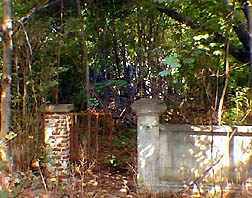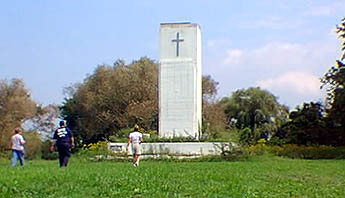Judith Colgan pointed out that, when she was a child, the island was not much developed south of the house that served as residence for her grandfather and his family. Many of the abandoned buildings now in its vicinity weren't there then during his heading the welfare shelter for homeless men.
The City Cemetery had not yet extended its operations into the southern end of the island. "As a child, I was vaguely aware something of the sort was going on elsewhere on the island, but it never made an impression on me as a little girl," she said. "I don't think I really understood about death at that age. But I do remember the old men my grandfather tried to help and to whom he insisted I show respect." Mary J. McDonnell identified as "the TB building" a structure on the next block over from the tumbled-down ruin of what was once her Hart Island home. The stone structure stands at the edge of what is the current section of City Cemetery burials. Correction Officer Michael Cassara said he had heard it was once used as a kind of theatre to show movies to the inmates and to stage entertainments. Mary commented, "In my time, the building was used for the inmates with TB. Maybe later when TB stopped being such big public health problem, at least for a while, the building might have been put to other uses."
After spending some time viewing the City Cemetery section currently used for burials, the group boarded the bus that then drove to an older, more landscaped section north of the complex of abandoned buildings. The bus stopped near the shore facing Long Island Sound. There Patricia Murphy recalled that the beach -- now strewn with debris washed shore after storms -- was once the scene of many happy summer swim parties. She looked around for the screened beach house from that era. All she found were the foundation-like stones and bricks where the beach house had been. "I remember that when we were old enough to have parties here ourselves we had to be very careful not to leave any of the bottles behind; otherwise maybe one of the inmates might find it and drink whatever little was left."
The ladies asked Officer Cassara whether people out in their boats on the Sound ever come ashore attempting to use the beach for recreation. He noted the island was well posted with warnings that read "Prison: Keep Off." The few boaters who don't see the signs or who are tempted to try to come ashore anyway are quickly, politely but firmly dissuaded from doing so by the officers assigned to the island. The unwelcomed visitors are made to realize their attempt to visit, if they persist, could result in stay for much longer than they would care to experience, the officer explained. Go-Home-to-Hart starter ----------- Hart Island Menu page ----------- Next Go-Home-to-Hart page | ||||||



